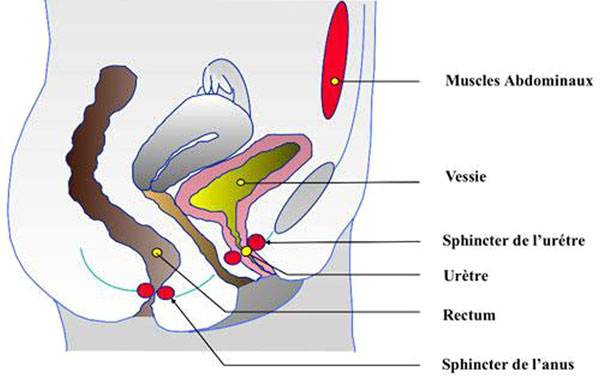Urinary incontinence is an involuntary leakage of urine that causes discomfort. There are several types of urinary incontinence:
- Stress Urinary Incontinence (SUI): leakage occurs at the time of exerting force (by a sports activity, coughing, laughing, sneezing, walking, changing position, etc.).
- Urge Urinary Incontinence (UUI): it means that the need to urinate is (often) urgent and uncontrollable.
- Mixed Urinary Incontinence (MUI): it combines the symptoms of stress incontinence and urge incontinence.
The consequences:
- The weakness of the muscles of the perineum (part of the body at the bottom of the small pelvis where the ends of the urinary, the genital and the digestive track all cross) that are responsible for supporting the bladder and the urethra (the tube that carries urine out of your body).
- The weakness of the sphincter of the urethra (the muscle responsible for closing the bladder).
Woman are by default disadvantaged in this respect because their urethra is very short, their sphincter is not too powerful, and their perineum is weakened by the several holes allowing for the passage of the urethra, the vagina and the rectum. Their perineum is strained during the pregnancy and especially by giving birth.
Finally, the lack of hormones after the menopause leads to the tissues getting dryer and an additional vulnerability.
If perineal rehabilitation fails or the stress incontinence is very significant, intervention is currently one of the most effective ways to make SUI disappear on the long term.
At the moment, there is no efficient medication to treat stress incontinence.
t consists of placing a small synthetic strip under the urethra. This strip will stay under the urethra like a hammock, supporting it at the time of exerting force to prevent leaks.
Note that this intervention can not bring relief in the case of all types of urinary incontinence. Your doctor will decide if this technique is appropriate after having examined your case and carrying out a few complementary examinations, such as a urodynamic assessment.
During the operation that is carried out with the patient lying in the gynaecological position, a small incision of 2 cm is made inside the vagina. The strip is passed through this little hole and positioned under the urethra the using needles.
Placement of a sub-urethral strip
The intervention takes 20-30 minutes.
Patients usually stay in the hospital for a couple of hours to up to 48 hours.
The intervention goes with little pain. The thighs may be painful for a few days afterwards. This is because of the use of the needles during the operation.
The average convalescence period lasts for two weeks, but the time needed before taking up work again may differ according to your profession. As soon as you leave the hospital, you can resume your normal activities, but you have to avoid strong efforts and carrying loads heavier than 5 kg for a month.


